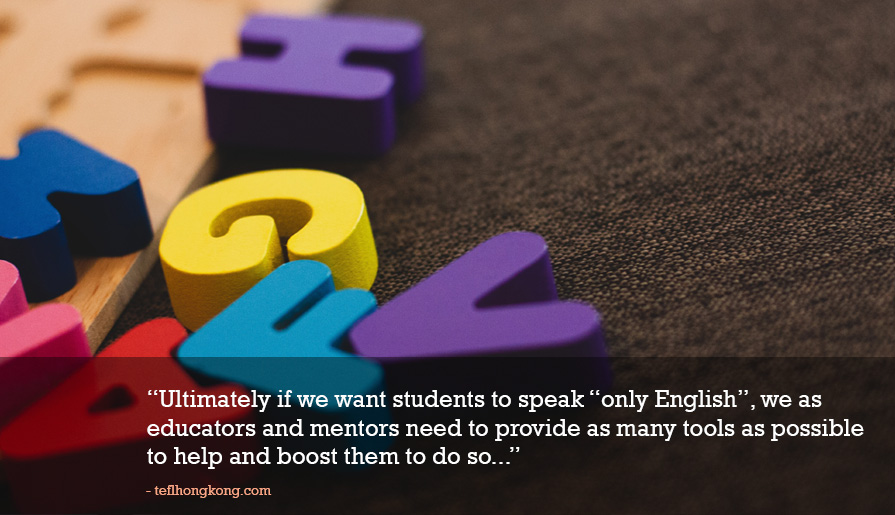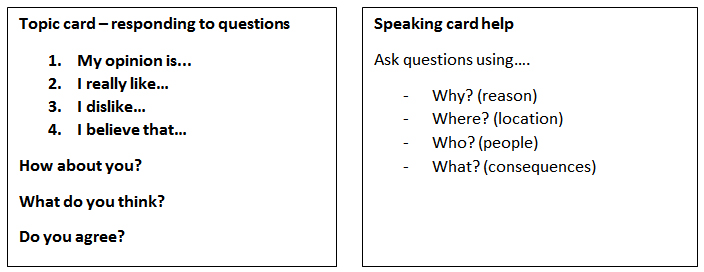
- By: Anna McIver
- In: Teaching Skills
I am sure every ESL teacher (or most of them) at some point had to remind their class to speak in English. Perhaps to stop gossiping in their native language or to avoid providing definitions or synonyms in their own language rather than providing a lengthier response in English?
It is, of course, incredibly common for students to resort to their native tongue when words fail them or to explain a complex point. However, as English teachers, part of our role is to aim for English throughout the class as this improves learning outcomes.
In this article, we will take a look at ways of helping you achieve this within your ESL classroom and share a few tips and ideas too.
So firstly, is it realistic to expect only English in the classroom?
To attain a full immersion (English only) ESL classes are challenging, and as teachers, we don’t need to push for 100% English 100% of the time. Having said that, we would always suggest to keep your expectations high and to make sure you do remind your students of the need for English.
This can be a gentle spoken reminder, or you can have related signs displayed in your classroom – if you’re allowed to do so.
To make it more excited, you can consider a game with a points system leading to prizes for those who speak the least of their native language.
A friend teacher of mine even had a ‘bring me a chocolate’ approach if a student spoke the local language.
It is probably unrealistic to expect pure English and not hear any of a student’s native language before the B2/Intermediate level, although it isn’t impossible. Positively at higher levels, students should not be speaking their native language and should be searching for new vocabulary and ways of expressing themselves without resorting to their mother tongue.
“Learning another language is not only learning different words for the same things but learning another way to think about things.”
– Flora Lewis
How can we encourage students to speak only English in the classroom?
In classrooms of any age group, having display-boards with key phrases and questions is a useful resource. This allows students to practice questions and phrases with guidance. This also enables them to become more accustomed to speaking English with both their teachers and their classmates. Short and simple statements like:
‘What’s the date?’
‘Can you please explain again?’
‘Can you help me?’ and so on, should be used more often by teachers and students.
With younger learners, consider making things into a game and use encouragement and praise as much as possible. Even when students ask questions in their native language, we should stick to English in responses and use this as a learning tool.
For example, if a student asks ‘What’s the time?’ – in their native language – respond by repeating the question in English, asking them to repeat the question in English, followed by praise and then tell the answer.
While handling speaking or conversation activities in the class, an excellent way to ensure speaking of pure English is to provide hints, cards with ideas, key vocabulary, questions and sentence starters to guide your learners.
This will help them to feel more confident and not have them struggle at the first hurdle. In many classrooms, students fall back to their native tongue due to the lack of confidence. So, if we can provide scaffolding and differentiation, we can help them to some extent.
Even something as simple as the following examples can make a big difference.

Ultimately if we want students to speak “only English”, we as educators need to provide as many tools as possible to help and boost them to do so.
Tips and Ideas
- Many students will be listening to English language music and are often keen to learn songs and understand the lyrics of their favourite bands or singers. Using lyrics to a popular song and doing some work around it tends to work well. You can focus on adjectives, phrasal verbs, identifying language or grammar patterns – there are lots of possibilities.
- Kinaesthetic activities which get students moving while also responding to English can help them remember vocabulary and phrases better.
- For young learners, use some numbers! Yes, although this sounds strange, students recognise numbers, and they are often the same in their mother tongue. This provides a sense of familiarity and thus increases confidence. So why not incorporate an occasional mathematics problem or facts using figures into some of your classes?
When giving instructions, try the following to ensure students understand:
- a student reads the instructions aloud from the board or textbook, as appropriate.
- the teacher explains using other words, as a summary.
- another student explains what to do in their own words.
- the teacher keeps a check and asks for questions if any.
These steps can seem lengthy at first, but including them makes a big difference for learners and helps avoid confusion before beginning a new task.
Final thoughts and takeaways
To conclude, we know as teachers that there may be occasions where students feel the need to resort to their native language in the class. We may also save ourselves a lot of time by swiftly providing a word or definition in the learner’s language to avoid a lengthy acting out process or the need to explain in great detail!
However, we do feel that English should be the primary focus! After all, it is an English classroom, and we want students to make progress. An immersive context alongside encouragement, support and a friendly approach will help students feel more comfortable speaking aloud and help them to become relaxed and at ease with language until it becomes natural for them.
We hope you can take something from this article and perhaps incorporate some ideas into your ESL class in the future.
Please Share:This article was originally published on March 9, 2020 and was last updated on November 14, 2020.
Courses We Offer:

1. CertTESOL: Certificate in TESOL
A level 5, initial teacher training qualification for new and experienced teachers, enabling you to teach English anywhere in the world. The course is equivalent to Cambridge CELTA.
Learn More